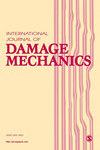Analysis of new damage evolution models for early age concrete
IF 3.9
2区 工程技术
Q2 MATERIALS SCIENCE, MULTIDISCIPLINARY
引用次数: 0
Abstract
Concrete cone (or breakout) failure mode is the dominant failure for cast-in headed anchors under tension in mature brittle concrete, however, other failure modes such as plug failure has been found experimentally to dominate in early age concrete. Design codes generally assume concrete cone failure and do not cover plug failure. A new model for concrete at early ages is proposed based on continuum damage mechanics which can model both failure modes for cast-in headed anchors in early age concrete. The new damage model combines a modified power law for the onset of damage, an exponential softening law for the post-failure softening stage, and an additional modified power law to reproduce the final stages of fracture. The combined damage law is calibrated with three experimental tests for concrete at two different ages (43 hours and 14 days): uniaxial compression, Brazilian splitting tensile and wedge splitting tests. The new models are applied to investigate anchor pull-out failure to demonstrate that both cone and plug failure modes are produced depending on concrete age. Simulations using the combined damage evolution laws gave the lowest average percent error over the mechanical properties measured in the four tests, when compared with existing damage evolution laws.早期混凝土损伤演化新模型分析
在成熟脆性混凝土中,混凝土锥(或破口)破坏模式是浇筑头锚杆受拉的主要破坏模式,但在早期混凝土中,实验发现其他破坏模式如栓破坏也占主导地位。设计规范一般假定混凝土锥体破坏,而不包括堵头破坏。基于连续损伤力学,提出了一种新的混凝土早期损伤模型,该模型可以模拟早期混凝土浇头锚杆的两种破坏模式。新的损伤模型结合了损伤开始时的修正幂律,破坏后软化阶段的指数软化律,以及再现断裂最后阶段的附加修正幂律。综合损伤规律通过混凝土在两个不同龄期(43小时和14天)的三个试验试验进行校准:单轴压缩、巴西劈裂拉伸和楔形劈裂试验。应用新模型对锚杆拔出破坏进行了研究,结果表明,随混凝土龄期不同,会产生锥型和塞型两种破坏模式。与现有的损伤演化规律相比,采用复合损伤演化规律进行的模拟得到的力学性能平均误差百分比最低。
本文章由计算机程序翻译,如有差异,请以英文原文为准。
求助全文
约1分钟内获得全文
求助全文
来源期刊

International Journal of Damage Mechanics
工程技术-材料科学:综合
CiteScore
8.70
自引率
26.20%
发文量
48
审稿时长
5.4 months
期刊介绍:
Featuring original, peer-reviewed papers by leading specialists from around the world, the International Journal of Damage Mechanics covers new developments in the science and engineering of fracture and damage mechanics.
Devoted to the prompt publication of original papers reporting the results of experimental or theoretical work on any aspect of research in the mechanics of fracture and damage assessment, the journal provides an effective mechanism to disseminate information not only within the research community but also between the reseach laboratory and industrial design department.
The journal also promotes and contributes to development of the concept of damage mechanics. This journal is a member of the Committee on Publication Ethics (COPE).
 求助内容:
求助内容: 应助结果提醒方式:
应助结果提醒方式:


